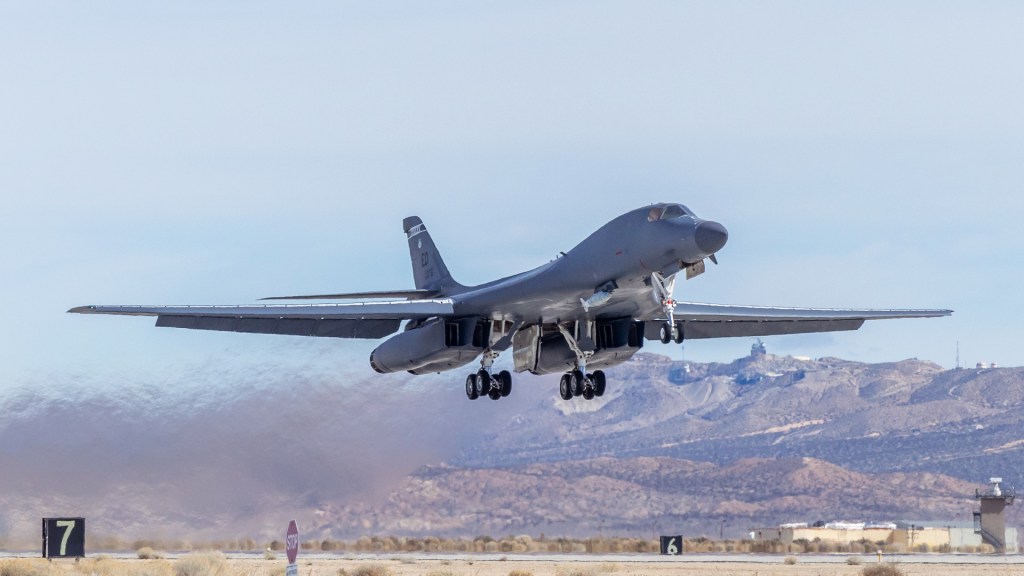Amid the looming threat of a conflict with China in the Indo-Pacific, the US Air Force’s (USAF) B-1B Lancer bomber has successfully been tested with a new pylon, greatly enhancing its ability to carry weapons even as the aircraft approaches retirement.
The 412th Test Wing of the USAF recently tested a new weapon pylon on a B-1B Lancer test aircraft with the 419th Flight Test Squadron at Edwards Air Force Base in California. The USAF said that this new modular pylon, dubbed ‘Load Adaptable Modular (LAM) Pylon,’ might remove the conventional weapon limitations.
The service’s press statement indicated that the new pylon was installed on the B-1B since that aircraft was available at Edwards Air Force Base. However, the LAM can be modified for attachment to other aircraft if needed.
Developed by Boeing, the LAM has been designed to carry a range of existing traditional and new weapons with smooth transitions. Thanks to its flexible mounts and attach points, it maximizes agility and makes the weapon testing infrastructure more robust.
The USAF stated that “the unique pylon is designed to carry a variety of standard and emerging weapons with a seamless transition, allowing for maximum agility while also strengthening weapon test infrastructure. While the B-1B was chosen due to aircraft availability at Edwards, the LAM can be modified for attachment to a variety of other aircraft if the need were to arise.”

The B-1B (also known as the BONE) is one of three heavy bombers in the US Air Force, the others being B-52H Stratofortress and B-2 Spirit. All three bombers are expected to play a crucial role in any potential combat against China in the Indo-Pacific region.
For instance, following the inauguration of Taiwan’s new President, Lai Ching-te, the US Air Force sent Rockwell B-1B Lancer bombers to Guam as a show of force in the Indo-Pacific amid growing tensions with China. The long-range strategic bombers were deployed to Guam as part of a routine Bomber Task Force (BTF).
Guam is a strategically located US territory in the Pacific that is expected to be a launchpad for operations against China in the event of a conflict.
However, the testing of LAM pylons on the B-1B is remarkable and intriguing, given that the bomber is inching closer to its retirement in the 2030s. The bomber, which has been combat-hardened over the years, will remain the driving force behind the American military’s offensive capabilities until the new B-21 stealth bombers are inducted.
Despite its retirement on the horizon, the B-1B’s stature has only grown due to its capability to carry varied and heavy payloads over long distances. The B-1B boasts the highest conventional payload capacity of any Air Force platform, even with the arrival of newer bombers.
One of the mainstays of the US Air Force’s bomber fleet, the B-1B Lancer, has undergone major modifications that include a new defensive avionics system, a revised Identification Friend or Foe system, and Link 16 tactical data communications. Thus, a new LAM pylon is not surprising.
However, it certainly becomes even more significant as the B-1B is expected to be a hypersonic weapon testing platform. Although the Air Force did not address the idea of the LAM accommodating hypersonic weapons in its release, Boeing officials had previously brought up this subject concerning the pylon.
B-1B’s New Pylon for Hypersonic Testing?
In May of this year, Boeing announced its proposal for the Air Force to transfer hypersonic missile testing from the B-52 to the B-1. It would be accomplished by using a new bomber pylon, which would have the extra benefit of increasing the B-1’s munition-carrying capacity by 50% for many current weapons.
At Tinker Air Force Base in Oklahoma, Jennifer Wong, Boeing’s director of bomber programs, told reporters, “The whole point of this is for the B-1 to become the Air Force’s hypersonic testbed.”
“Because of all the modernization efforts on the B-52, we cannot take away from what we’re doing on the B-52 today to have it test hypersonics,” Wong explained. “So, we will be doing hypersonics testing on the B-1.”
Some experts suggest that the B-1’s ongoing significance until the entrance of the B-21 Raider stealth bomber, which is presently in testing, could depend on the integration of hypersonic weapons. This becomes significant since the USAF is testing a host of air-launched hypersonic weapons as it trails behind China in the hypersonic race.
Experts surmise that the external hardpoints of the B-1, which were deactivated as part of the nuclear armaments START (Strategic Arms Reduction Talks), are suitable sites for the installation of the LAM. With Russia withdrawing from the START treaty, these bombers can now use external hard points to carry more munitions.
The bomber could carry 24 weapons in its internal weapon bays and an additional 12 externally by installing six LAM pylons.
Boeing previously stated that the B-1 will eventually be equipped with six LAMs, each capable of carrying two missiles. The company further mentioned that the missiles would be of two types: boost-glide vehicles and air-breathing missiles.
Nevertheless, the Pentagon and the United States Air Force have yet to make a call on the proposal. However, the Air Force is showing signs that it wants to delegate part of its hypersonic missile testing to the B-1, even though the B-52H Stratofortress has led the charge thus far.
- Contact the author at sakshi.tiwari9555 (at) gmail.com
- Follow EurAsian Times on Google News